Day 2
Sunday, 20 October
Te Pahu Road to Kaniwhaiwha Stream (15 km)
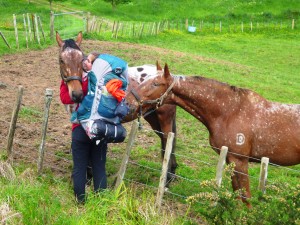 The day started well. We found two appaloosas near Old Mountain Road. One of them had a particularly beautiful spotty bottie. When I was a teenager, I also had a spotty bottie; unfortunately, they were the wrong kind of spots.
The day started well. We found two appaloosas near Old Mountain Road. One of them had a particularly beautiful spotty bottie. When I was a teenager, I also had a spotty bottie; unfortunately, they were the wrong kind of spots.
Old Mountain Road involves a long climb. We were looking for trail signs leading to the left through paddocks, but saw none at the point where the GPS indicated we should turn. At an unmarked gate, a with track bore in the correct direction for Limeworks Loop Road. So we took this route. After about 400 metres, we found a trail sign, but it pointed further up the mountain instead of further along the farm track. We consulted the trail map, but it did not clarify matters, other than to indicate that the trail wriggled in a red line southwards. We were puzzled, but the sight of more signs higher on the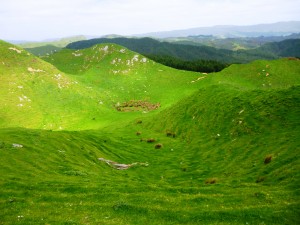 mountain drew us upwards. Here, the view was spectacular. Valleys scooped away from the peaks with viciously green grass broken through by scabs of pale rock.
mountain drew us upwards. Here, the view was spectacular. Valleys scooped away from the peaks with viciously green grass broken through by scabs of pale rock.
Two dark figures approached from ridge above us. Deep within, I felt a frisson of alarm. A vestige of Africa still squirms in my guts. In an isolated South African place, to be wary is to survive. However, the figures morphed into two cheerful and elderly American ladies. One of them was carrying a rock the size of Gideon’s Bible. I wondered how long, on such a steep walk, she would remain attached to it.
Puzzlement continued when the track took us back to Old Mountain Road. But a sign indicated that the track beyond the road was part of the Te Araroa Trail. The trail notes did not say that the track re-crossed this road, but the trail notes are so often inaccurate that we trusted the orange triangles this time.
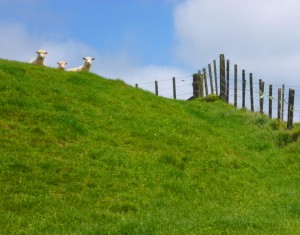 It was high and windy country, grazed by sheep and with rock layers that sat up, jostled from the horizontal by a massive and ancient force. Faintly, in the distance, we could see a smudge that was Hamilton. The sheep maintained a constant bleating transmitted to flock after flock as we passed. The older ones were clearly warning the younger how dangerous we were. Like humans, each sheep had a different voice, from soprano down to baritone. Great Aunt Ethel’s bleat was deep and hoarse, and it became particularly quavery when she related the scary bit about gra-a-a-avy and mint sau-au-au-auce.
It was high and windy country, grazed by sheep and with rock layers that sat up, jostled from the horizontal by a massive and ancient force. Faintly, in the distance, we could see a smudge that was Hamilton. The sheep maintained a constant bleating transmitted to flock after flock as we passed. The older ones were clearly warning the younger how dangerous we were. Like humans, each sheep had a different voice, from soprano down to baritone. Great Aunt Ethel’s bleat was deep and hoarse, and it became particularly quavery when she related the scary bit about gra-a-a-avy and mint sau-au-au-auce.
“I keep getting the feeling that we are heading north instead of south,” I said to Hannah. 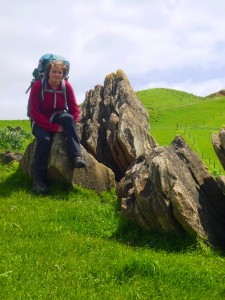 “But I must be wrong.” We consulted the map again but could not work out where we were on the red line. What we could hear in the distance, though, was a motorway’s unmistakeable Doppler shift.
“But I must be wrong.” We consulted the map again but could not work out where we were on the red line. What we could hear in the distance, though, was a motorway’s unmistakeable Doppler shift.
Tramping through the grass towards us came a lady. “Where are we?” I asked her, as if we were Victorian damsels just surfacing into consciousness from a swoon. It turned out that we were way off course. We had indeed come north and we were now close to the SH23, which could take us to Raglan or (O’Dea!) back to Whatawhata. It was so depressing to know we had lost a day’s walk. And then, the beautiful lady unfurled her wings, took her halo out of her pocket and placed it on her head. Yes, Elizabeth is actually an angel. (You see, Hannah? Again, we have evidence of God!) She turned back from her afternoon’s walk, accompanied us to the SH23 where her car was parked, and drove us to where we should have been by now, the DOC picnic spot on Limeworks Loop Road. What a relief.
And meeting Elizabeth was serendipitous. She is also a writer, and her book of short stories, After, is just about to be published in Wellington. The stories are linked with the theme of grief and some of the material emerged from her own bereavement nine years ago. I’m going to buy a copy of After when it hits the bookshops.
We had a short walk to the DOC campsite at the Kaniwhaiwha Stream. Here, dustbins were provided! Excuse the excitement, but this is the first time we’ve found dustbins for campers. At all the other DOC places, we’ve had to carry our rubbish out with us, so we happily shed our small bag of junk.
We decided that the distance we had walked on the trail marked in the countryside as part of Te Araroa, and not updated on the official map as an alternative route from Whatawhata, would substitute for us for the section of the Kapamahunga Walkway from which we had been diverted. The distance is equivalent.
After dinner we took comfort from Adrian Mole. “I’ve got some filthy habits, cocker,” Bernard confesses to Adrian, “like turning my underpants inside out on alternate days.” We laughed. “It sounds just like us when we’re camping,” said Hannah. Too right! My glamour quotient is very low, but Hannah’s is now subliminal. Although she remembered her backpack on Saturday, it was an exertion of mental vigour insufficient for the inclusion of her toothbrush. But more important problems lay ahead of us. Tonight, we finished The Prostrate Years, the last book in the series. How can we possibly continue on the trail without Mole?
Day 3
Monday, 21 October
Kaniwhaiwha Stream to the Pahautea hut (7.5 km)
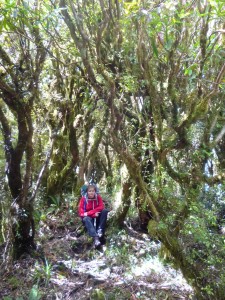 Today took us to the 959-metre summit of Pirongia Mountain. The distance was only 7.5 km, but it took us about six hours. In some places, we could see a path, but for much of the distance we had only the orange trail triangles to guide us. The GPS told us we were about 120 metres east of our actual location. In open country, such inexact information is annoying but not dangerous because you can see where you have been and where you are going. In thick bush, losing the trail could be serious.
Today took us to the 959-metre summit of Pirongia Mountain. The distance was only 7.5 km, but it took us about six hours. In some places, we could see a path, but for much of the distance we had only the orange trail triangles to guide us. The GPS told us we were about 120 metres east of our actual location. In open country, such inexact information is annoying but not dangerous because you can see where you have been and where you are going. In thick bush, losing the trail could be serious.
Large sections of this track were waterlogged. The muddy sections held some comfort, because we could see the reassuring bootprints of trampers who had preceded us. However, the mud was deep, and the steep ups and downs of the track meant we both frequently hit the ground with a squeal and a meaty thump.
The undergrowth on the lower mountainside here was not as dense as in the Hunua 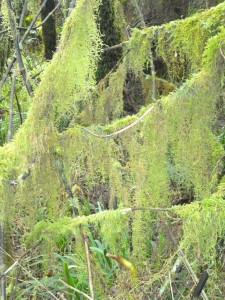 Ranges, but it was thick, so on only about three occasions on our way to the summit was there a sufficient break in the vegetation for us to see some of the view. But we couldn’t determine how far we were from the top, and that was demotivating. The climb felt endless.
Ranges, but it was thick, so on only about three occasions on our way to the summit was there a sufficient break in the vegetation for us to see some of the view. But we couldn’t determine how far we were from the top, and that was demotivating. The climb felt endless.
Two incidents enlivened the day. 1) I threw up. 2) Hannah sat in a red ants’ nest. When we rested on a mossy rock, she felt something nipping her back. Her pack had to be hurriedly dropped and her clothing shifted radically as her mother slapped off all the feisty little insects. They were set on world domination, invading even her underwear. At such times you are grateful for a time and a track where there is almost no chance of hearing “Well, hello there, ladies!” from another tramper offering to share his packet of mandarins with you in the friendliest way.
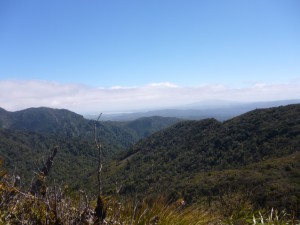 We realised we had reached the summit when we came upon a sign and a metal platform above the path. There was no other way of knowing this was the place to plant our pink girlie flag, because the vegetation is too thick. I leaned against one of the platform poles and slowly subsided to the ground. “You go up and take a picture of the view to prove we were here,” I cravenly told Hannah. “I am really too tired to give a damn what it looks like.” Hannah reached down into her bowels of endurance and found a handful of something sufficient to act as a counterweight to haul herself up the steep metal stairs, while I lay pathetically below with my eyes closed, breathing shallowly. “Pissy shit tits!” I heard her scream. OK, I had to climb up too. And yes, the 360-degree view is indeed compulsory viewing. Luckily, the sun had emerged that afternoon, so although there was a haze in the distance, visibility was good.
We realised we had reached the summit when we came upon a sign and a metal platform above the path. There was no other way of knowing this was the place to plant our pink girlie flag, because the vegetation is too thick. I leaned against one of the platform poles and slowly subsided to the ground. “You go up and take a picture of the view to prove we were here,” I cravenly told Hannah. “I am really too tired to give a damn what it looks like.” Hannah reached down into her bowels of endurance and found a handful of something sufficient to act as a counterweight to haul herself up the steep metal stairs, while I lay pathetically below with my eyes closed, breathing shallowly. “Pissy shit tits!” I heard her scream. OK, I had to climb up too. And yes, the 360-degree view is indeed compulsory viewing. Luckily, the sun had emerged that afternoon, so although there was a haze in the distance, visibility was good.
The very thick bushy growth at the summit is broken through by tall, leafless silver trunks. 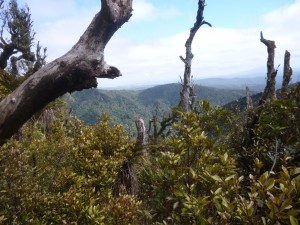 These trees are all long dead – nibbled to death by possums.
These trees are all long dead – nibbled to death by possums.
By mid-afternoon we reached the DOC hut and we were the only souls at the campsite. It was fantastic to have a roof instead of a tent for the night, well worth the $10 honesty donation. Hannah found a quarter of a bar of chocolate which a previous occupant had left behind, so she promptly ate it despite my yelps of protestation. (Child Youth & Family, if a staff member is reading this, you will be interested to know that my child now has to scavenge to survive.) “But how old is it?” I asked. “Meh! Only expires in 2014,” she said with a flick of the wrist.
This was our first Moleless night. I had suggested that Hannah bring Roy’s The God of Small Things with us for this inevitable moment, but she said she didn’t want any serious stuff after walking, so as we left home I had snatched up Sharpe’s Wilt. This book is farce, but too many rude bits render it unsuitable for reading aloud at bus stops. In the wilderness, it wouldn’t offend anyone, but I did wonder how good a role model for virtue, vocabulary and literature selection I was being for my child, even though she sees and reads much more startling stuff online. Hannah had a simple solution for the problem. “We’ll read the rude bits to each other in foreign accents,” she said. “That will make everything all right.”
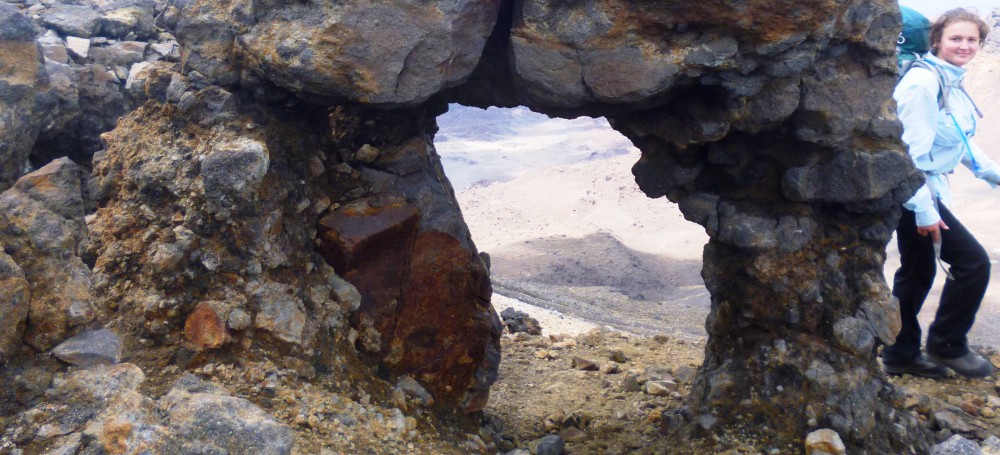
”Victorian damsels just surfacing into consciousness”
I am trying very hard to imagine the above, not succeeding.
love photos and the story telling.
keep walking ladies.
Sounds like this was a really tough leg. Good for you. I look forward with eager anticipation to your posts.
Thanks Dina.